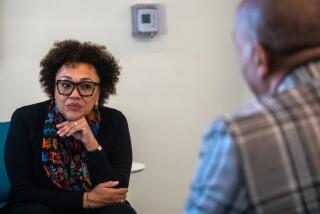In Perfect Balance : Joan Abrahamson’s Remarkable Life, So Far
- Share via
Joan Abrahamson brings creative ideas to people with the power to use them best. Elegant combinations of ideas and people emerge into her consciousness the same way melodies and lyrics do when she writes popular songs, interrelated and almost fully formed.
She’s equally at home in the White House, where she worked 4 1/2 years for George Bush, and in her studio in Manhattan’s Soho, where she paints large, non-representational canvases left-handed and draws smaller, realistic works ambidextrously.
Her artistic intuition has never failed her. It led her to major in fine arts, philosophy and psychology in Yale’s first class of women, to call off the wedding scheduled for Harkness Chapel just after graduation, and to return, single, to the Bay Area for a master’s in educational planning at Stanford.
One day, while searching San Francisco for a cheap studio in which to paint, she walked past the Army’s unused Fort Mason pier. Someone had left a gate wide open. It attracted her. She walked through it and looked around.
Years and uncounted skirmishes later, the city had an arts center at Fort Mason. In part to bolster her credentials in writing its environmental-impact study and negotiating its title transfer, she’d acquired a Ph.D. in learning environments at Harvard and a law degree at UC Berkeley’s Boalt Hall.
She worked briefly in Europe for the U.N., and as a White House fellow was assigned to vice president George Bush, remaining after the fellowship as Bush’s chief of staff.
One sunny Memorial Day in a Georgetown cafe, at lunch counseling a female graduate student, she was asked about her work plans after the White House. In a burst of conversation more prophetic than her stroll through the Fort Mason gateway, Abrahamson created the Jefferson Institute.
Named for the third President, an architect, diplomat, educator and monetarist, the institute, she said, would “identify and seek solutions to major societal concerns in the areas of creativity, the future of cities, international security and international economics.”
Courted by USC economist-professor Jonathan Aronson, whom she’d met while applying for the White House fellowship (which she received and he did not), she listened to his marriage proposal, delivered as they walked her favorite beach in San Francisco’s Sea Cliff district, near her parents’ house. She decided a month later, just as they toasted glasses of red wine in the lobby of New York’s Algonquin Hotel, to accept.
She accompanied the vice president to Japan, India, Pakistan’s Khyber Pass and the Sultanate of Oman, flying to her wedding in Tiburon and honeymoon in Paris. She and her husband returned to find their maid of honor and best man, who’d met for the first time at the wedding, in love and engaged.
She incorporated the Jefferson Institute, rejoined Bush’s staff briefly, and on June 17, to her surprise, was awarded her so-called Genius Award by Chicago’s John D. MacArthur Foundation.
Now dividing her time between New York and Los Angeles, with forays to the Salk Institute in La Jolla, where she has an office, she’s painting for a one-woman show and developing more projects.
She’s imported Seattle’s Kidspace Program--which surveys children’s attitudes and uses the results to reorient city facilities to the needs of children and families--to San Francisco, and also has San Diego officials interested in it. She’s started a program to revitalize New York’s commercial theater.
“I’m concerned with creativity itself,” she says, “and becoming a bridge between creative ideas and people in a position to implement them.”
More to Read
The biggest entertainment stories
Get our big stories about Hollywood, film, television, music, arts, culture and more right in your inbox as soon as they publish.
You may occasionally receive promotional content from the Los Angeles Times.










